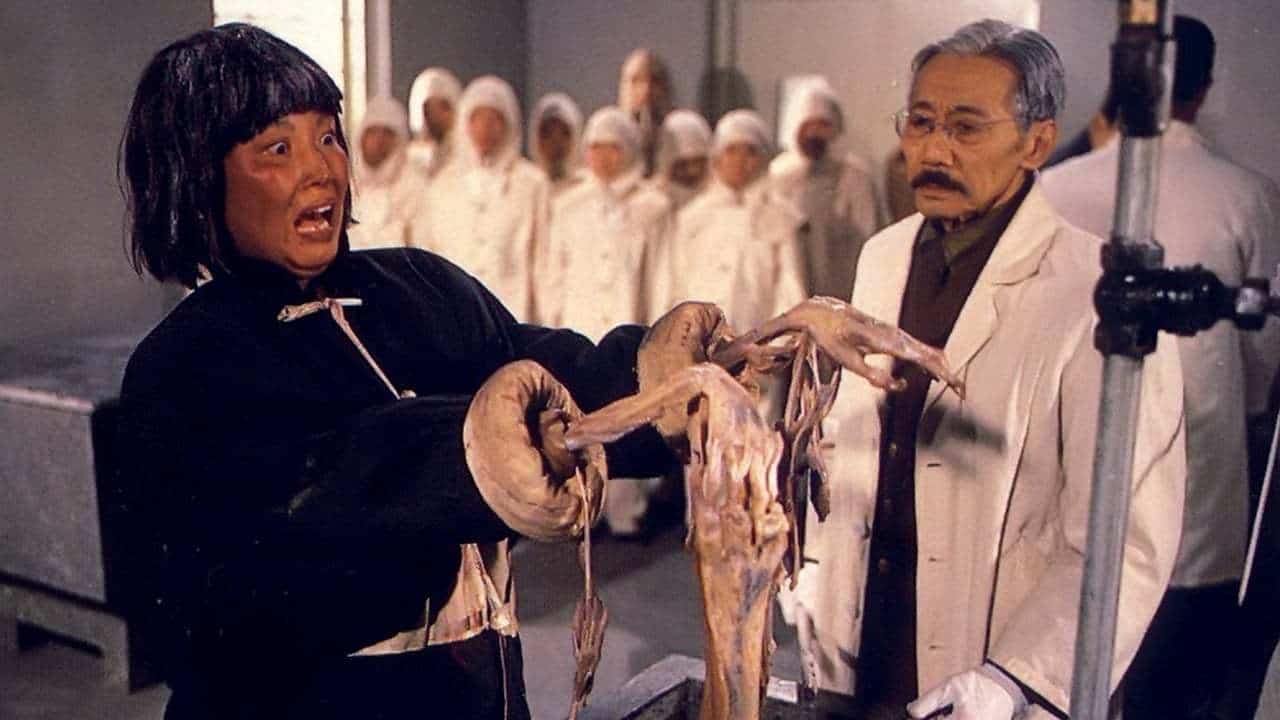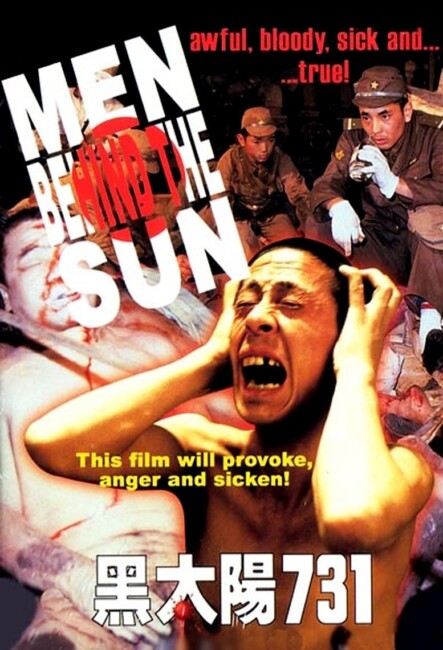(Hei Tai Yang 731)
Hong Kong. 1988.
Crew
Director – T.F. Mous [Tun Fei Mou], Screenplay – Don Jing Teng, Mei Fei Liu, Wen Yuan Mou, Producer – Fu Chi. Production Company – Sil-Metropole Organisation.
Cast
Gang Wang (General Shiro Ishii)
Plot
In 1945, during the Japanese occupation of the Manchuria province of China. General Shiro Ishii is placed in charge of Manchu 731, a secret internment facility, and given orders to develop bacteriological weaponry for the Japanese. Using what they call maruta, prisoners and racially inferior locals, Ishii conducts a series of experiments in testing extreme responses.
Men Behind the Sun is a film that exists in notoriety. A work of Taiwanese-born, Hong Kong-based director T.F. Mou(s), it is based on the true-life concentration camp set up by the Japanese during their occupation of China’s Manchuria province between 1931 and 1945. In 1936, Shiro Ishii (1892-1959), a Japanese army surgeon, was placed in charge of Unit 731, a camp built on a four square mile area near Harbin, China, with orders to develop bacteriological weaponry. In the unit’s eight years of operations, some tens of thousands were killed. These included prisoners of war and general criminals who were vivisected (often while still alive), starved, given forced abortions, left to die in sub-zero temperatures, placed under tests of extreme conditions or infected with bacteriological agents. Arrested after the War, Ishii was granted immunity from prosecution by the US government for turning over evidence from his experiments. His whereabouts after this period are not known. T.F. Mous learned of the story and determined to conduct as accurate a depiction as possible, including even going to shoot in Harbin.
There are a certain sub-grouping of films that you can point to that take everything to extremes as graphically and brutally as possible – works like Salo or 120 Days of Sodom (1975), Day of the Woman/I Spit on Your Grave (1978), Cannibal Holocaust (1979), NEKRomantik (1987) and A Serbian Film (2010). Men Behind the Sun belongs here. For a time, I thought maybe that it had been inspired by Ilsa, She Wolf of the SS (1974) and the cluster of sado-pornographic Nazi torture/concentration camp films that flourished for a time in the 1970s. On the other hand, it soon becomes apparent that T.F. Mous is making something far more sober and serious.
The film soon becomes a series of nastily uncomfortable torture scenes that are not for the faint-hearted. A woman is forced to stand outside in sub-zero temperatures for ten hours with her hands exposed, which are then plunged into boiling water and the skin stripped off. A man has his hands frozen at 100 degrees below zero and they are then shattered. Another man is placed inside a pressure chamber and we watch as his intestines splatter out of his anus and across the floor. The body of a nude boy is placed on an autopsy table and the organs are removed with no detail spared.

The scene that caused the greatest controversy when the film came out is one where a cat is thrown into a room filled with rats, which proceed to tear it apart. The scene comes in such alarming detail that it makes you wonder about the whole ‘no animals were harmed in the making of this production’ line, which clearly wasn’t being enforced in Hong Kong during the 1980s.
The film never consists of too much more than a catalogue of these atrocities. It is grim but undeniably strong and effective viewing. Beyond the catalogue of cruelties, there is not much of a plot to proceedings but the film does climax in the inevitable overthrow of the camp. The one thing that does kill the film considerably is that all of the prints available are the ones that have been dubbed for American release in atrocious voices that seem conducted by inexpressive truck drivers and in no way suit the characters or events depicted on screen.
There were several sequels Men Behind the Sun 2/Maruta 2: Laboratory of the Devil (1992), Men Behind the Sun 3: A Narrow Escape (1994) and Men Behind the Sun 4/Black Sun: The Nanking Massacre (1995).
T.F. Mou made around a dozen films as director in a career that stretched between the 1970s and 90s. These range from action, crime and thrillers to erotica. In genre material, he made the Wu Xia A Deadly Secret (1980); contributed to the anthology Haunted Tales (1980); made Lost Souls (1980), another grim and extreme work about women who are people trafficked; and returned to direct the last sequel to Men Behind the Sun, the abovementioned Black Sun.
Trailer here
Full film available online here:-


